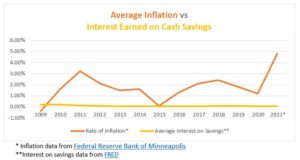Several of our clients have asked us why they should invest. We’ve worked with countless clients who contribute to their retirement accounts but leave the money in cash. We also have clients who’ve built a sufficient cash reserve but continue to add to their cash savings. While cash plays an important role in your short-term financial plan, investments add fuel to a long-term strategy. Please note that this blog is for educational purposes only and not investment advice.
The Problem With Cash
When you put cash into a savings account, as of this writing, you’ll earn about 0.06% on your money. While cash is safe because it doesn’t lose actual value, the problem is that over time, it loses relative value. Your dollars buy less over time because the overall cost of living increases due to inflation.
Based on data from the Federal Reserve Bank of Minneapolis, from 2009 through 2020, inflation averaged a fairly low 1.5%. (Sidebar: recently, the inflation rate has increased to over 4% and this could be a stable trend going forward.)
Your savings account however, typically earns less interest than the rate of inflation. The following chart with data from the Federal Reserve Economic Data (FRED), shows that since 2009, savings accounts have earned about 0.10% annually.
The “Why” of Investing
Over time, the purchasing power (the amount you can buy with each dollar) of your cash decreases. In that same period of time, the S&P 500, a measure of large US stocks, yielded an average annual return of 15.8%. (Sidebar: This is a rather high average return for US stocks. The long-term annual return is closer to 10% as illustrated in the chart below). Over the long term, investing in stocks allows your money to grow faster than the rate of inflation.

If the stock market yields a higher return, then why not just invest all of your savings in the stock market? You can see from the chart above that from year to year, the return is not stable or predictable. Some years, your investment might grow by double digits and other years, such as in 2008 and 2009, it could actually lose value.
Because of this volatility it’s important to build a cash fund of 6 to 12 months of expenses before introducing investments into your financial strategy. The exception to this rule is to contribute enough to your employer retirement account to earn the company match, which is essentially free money that will grow over time.
Now that we know why an investment portfolio is a powerful part of your long-term strategy, let’s look at the key types of investments available to you.


